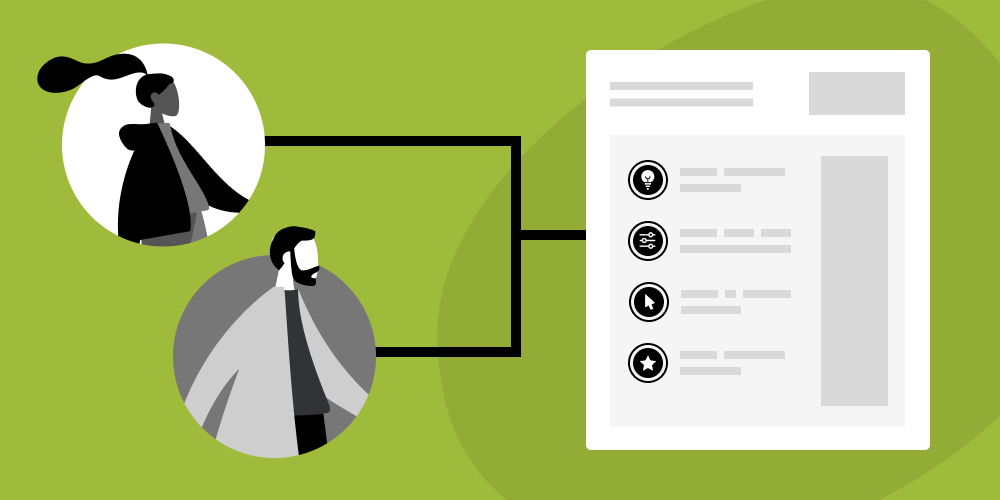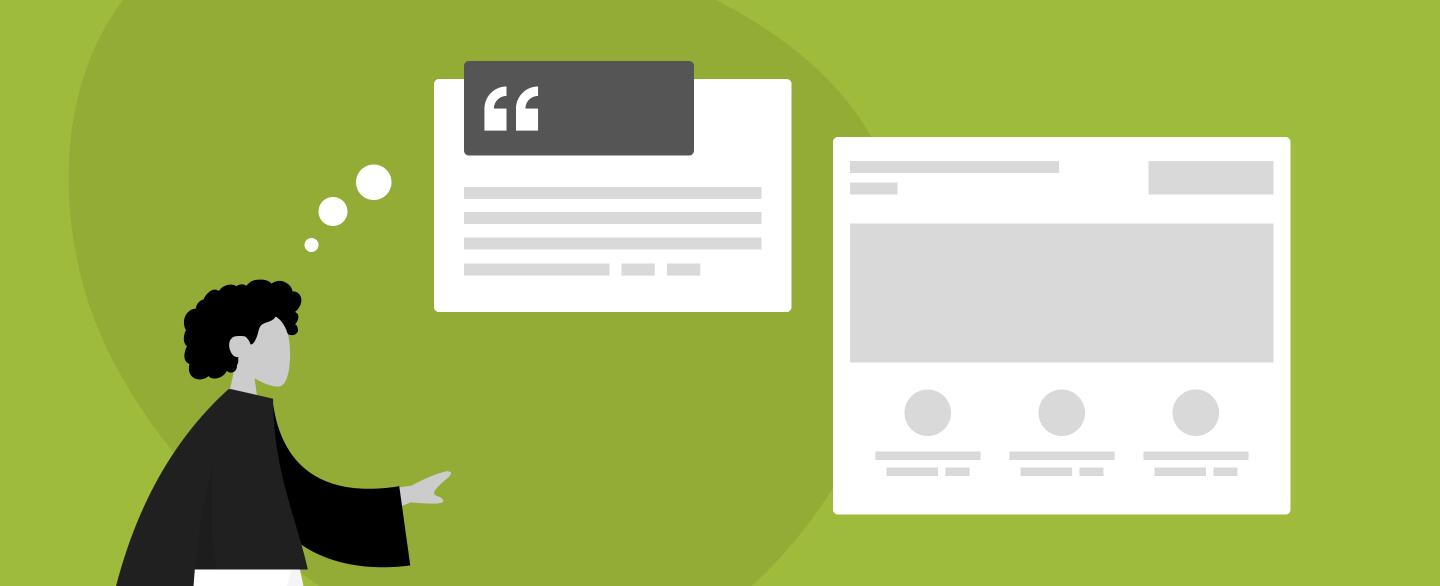It’s the moment your team has been waiting for. After compiling a detailed creative brief, working through an in-depth discovery process, and reviewing several rounds of wireframes, you’re finally getting a look at the designs for your new website. The big reveal! But when you see the layouts, you have some thoughts. You love some elements, but notice a few things that you want to change.
Communicating feedback to the design team is an essential part of moving any project forward. And it doesn’t have to be difficult, even as a non-designer or someone who’s less familiar with creative projects. The feedback process should be approachable and collaborative at every stage – whether you’re talking strategy, specifics, or final touches.
In this post, we’ll explain some general best practices for giving feedback on designs. We’ll also cover a handful of common scenarios and how to reframe comments to be productive and helpful to your designer. Skip ahead with the links below:
- Highlight Core Concerns
- Be Clear and Concise
- Ask Questions
- Focus on Goals
- Send Examples
- Consolidate Feedback
- Incorporate Positives
Highlight core concerns instead of specific fixes
When you’re responding to a design, it’s very common to put together a list of requested changes – things like “make this image bigger” or “reduce the whitespace on that page.” While specific feedback can be a helpful tool in some cases, it’s ultimately better for your project if you’re able to zoom out and explain the core concerns that are driving your requests.
You might think that this would slow down the process. Why not tell your designer exactly what you want to see? It’s important to remember that you’ve hired a professional for their knowledge and expertise. Even though you might think that a quick fix is the answer, your designer is able to consider best practices, accessibility, trends, and technical details when proposing a change or solution.
TRY IT: Let’s go back to the whitespace example. Instead of telling your designer to cut as much whitespace as possible, hone in on the issue that you’re concerned about. Are you worried that certain information is getting lost on the page? Maybe a better solution would be creating a new design element that helps the content stand out, or adding anchor links that allow users to jump to sections that are further down on the page.
A good designer will be able to look at the problem and think through a solution that will address your concerns while maintaining the integrity of the design. More often than not, they may even develop an approach that you hadn’t considered!

Be clear and concise
When it comes to your concerns, be clear about what you’re reacting to. General comments about “pop” or “wow factor” can be confusing to your designer because they don’t say much about what you like and dislike. Your designer may interpret a note about the missing “wow factor” as an instruction to go back to the drawing board, when you may actually be looking for different typography and a new background pattern on the same core layout. Clearly communicating your feedback is an essential part of avoiding misunderstandings and moving your project in the right direction.
TRY IT: Instead of saying something like “I’m just not feeling it,” address your likes and dislikes individually. That might sound like: “I love the large images and text treatment, but I’m not sure these colors will stand out in our industry. What are your thoughts on adding a new accent color?”
Ask questions
If you’re uncertain about some part of the design – maybe you don’t like it, or just don’t understand why it’s there – don’t hesitate to ask questions. Most design decisions are carefully rationalized based on project goals, user-experience, accessibility, and other factors. Your designer can explain why things look the way they look, including color choices, sizing, placement, and more. Once you understand the thought behind a decision, you’ll be able to assess whether or not the design is working for your project.
TRY IT: Let’s say that your main brand color is light green. When you see the design, you’re surprised that the buttons and headings are a different color – isn’t that less recognizable to your target audience? Instead of leaving a note about changing the color, try asking your designer why the green shade isn’t used more prominently. Your designer would be able to explain that the color isn’t appropriate for text because it doesn’t meet ADA accessibility standards. Aha moment! Understanding that part of the decision would enable you to move past your initial hangup about the color choice.

Focus on goals
When reviewing a design, most people have some type of quick gut reaction. You love it. You hate it. You kinda like it. And so on. In addition to considering your own opinion, it’s essential to think about the design in the context of your target audience and project goals. And sometimes that means separating your personal taste from what will resonate with future site visitors.
Of course your designer wants you to like the finished product, but their main objective is to create something that will accomplish the goals in your request for proposal or creative brief. That said, it’s important to prioritize big-picture objectives when thinking through feedback.
TRY IT: Imagine you’re facilitating a website redesign for a large nonprofit. You see the design and it’s a little…bland. Before leaning into your personal (negative) reaction, take another look while thinking back to the project goals.
Your organization’s main target audience is donors, who are mostly older couples that don’t spend a lot of time online. While you may respond better to a louder, high-impact design, your audience might be alienated by trendy effects or extra bells and whistles. So, it’s time to take yourself out of the equation: “I think our audience will really appreciate the straightforward nature of the design. The contrast between colors is working well because everything is clear and easy to read.”
Send examples
Whether you’re in the initial discovery phase or working to finalize designs, examples can be helpful for expressing style preferences or showing features that you might like to incorporate into your own project. Examples ensure that you and your designer are on the same page, especially if you’re not familiar with technical terms or industry jargon.
Your designer isn’t going to copy an example, but will use it to guide the design towards something that matches your general vision.
TRY IT: We find that examples can be used in two main ways:
- Early in the process, a collection of examples can help your designer understand your likes and dislikes. For instance, several inspiration sites might show that you tend to prefer full-width image mastheads or designs with space-saving features like tabs.
- A specific example can help to articulate a treatment or effect that you’re not sure how to explain. Think: hover effects, interactive elements, a cool typography feature, etc.
Consolidate feedback
For most projects, decisions are made by more than one person. Maybe a marketing director is leading the process, but a small committee and key executives are also expected to contribute to the conversation. While typical for a web project, multiple opinions can cause confusion when conflicting notes are included in the design feedback.
Contradicting notes are confusing to your designer because it’s impossible to know which voices should have the most influence – no one knows the nuances of your organization like you do. The best way around this issue is to evaluate the feedback and condense important and relevant points into a single authoritative document or email.
TRY IT: Instead of presenting a collection of notes and thoughts from various people, try sifting through and cutting irrelevant or conflicting requests that can be addressed on your end. For example, imagine that a department has requested several custom layouts that focus exclusively on their work. Rather than letting this feedback get back to your designer, remove it from the list and let the department know that the additional layouts would take the project out of scope.
Alternatively, if some of the feedback should be considered at a lower priority level, try rephrasing the notes in a way that clarifies the decreased importance: “Our [X] department would like to see a little more focus on their day-to-day work, but it’s not hugely important to the overall project goals. Could we try adding a small section to showcase the info without having it take over the site?”

Incorporate the positives
Sure, we all like compliments. But including positives in your feedback is more than just a way to boost your designer’s spirits – it’s a helpful tool for highlighting what you like and what you’d like to see more of. Maybe you’re happy with a particular layout, and would love to see the same structure mirrored on other pages. Your designer may not know unless you mention it!
Including positive feedback also goes a long way towards creating a friendly and collaborative working relationship. It never hurts to let someone know that their work is appreciated!
TRY IT: If you like something, just say it! That might sound like: “I love the way that the homepage calls out our mission statement. For the interior layouts, let’s have a similar intro section where we can feature other distinguishing factors about our work.”
Final Thoughts
Ultimately, feedback can have a real impact on the success of a project. While effective feedback can keep work moving smoothly, sporadic or irrelevant notes can slow down the design process and lead to last-minute scrambles and avoidable misunderstandings.
The next time you’re reviewing website designs, make sure to:
- Provide succinct feedback sooner rather than later
- Be open to talking about reasoning or rationale
- Look to your designer as a resource and expert – that’s why you hired them!





Leave the first comment